When you’re gardening, the right tool really does make all the difference! A good quality garden hoe is a standard addition to any gardener’s toolbox with good reason – it helps make weeding flower and vegetable beds easy, makes soil preparation simple, and is key to making those neat, orderly rows that are perfect for planting.
However, there are a lot of different types of garden hoe on the market, and it’s important to buy one that is suited to the jobs you want to do – and that it’s well-made so that it lasts!
More...
Best Garden Hoes for 2025
Product | Our Rating | Price | |
|---|---|---|---|
1. ErgieShovel Shank Pattern Blade Garden Hoe | 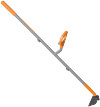 | ||
2. Mattock Medalist® 2kg & Fiberglass Handle Garden Cutter Hoe | |||
3. Japanese Craftsmanship Garden Hand Tool Hoe |  | ||
4. Spear & Jackson Dutch Hoe |
Different Types of Garden Hoes

Source: Amazon
There are several main types of garden hoe tools, each designed for different jobs. This includes:
Shovel or Draw hoe
Also called a general-purpose or paddle hoe, a draw hoe consists of a long pole with a rectangular or square edged paddle on the end set at a 90-degree angle to the pole.
This is called a draw hoe because you use a drawing action – first plunging the edge into the ground, then drawing it towards you to break up the soil. It’s used for breaking up compacted soil, hilling potatoes, chopping out weeds and preparing beds for planting.
Handheld hoe
Most garden hoes have a long pole handle, but this variety has a short handle, similar to a hammer. This garden hand tool hoe often has two usable ends.
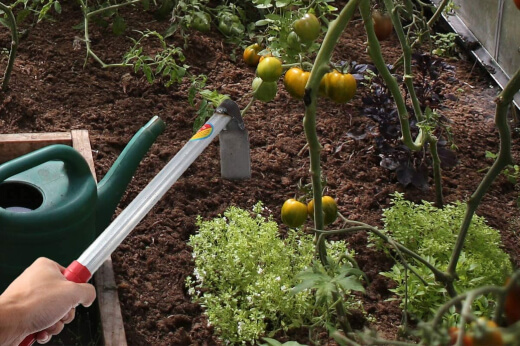
Source: Amazon
A shovel end for breaking up soil clumps or compacted soil and a forked end for pulling weeds and roots. It’s best for weeding and removing unwanted plants.
Dutch hoe
A Dutch garden hoe looks a lot like a shovel hoe that has had the shovel end hollowed out to create a hole the soil can move through. It is usually sharp on all three sides of the shovel, and is designed for moving through a layer of soil to slice away weeds and roots, operating like a large peeler.
How to Use a Dutch Hoe
How to Choose the Right Garden Hoe
Once you know what you want to use your garden hoe for, you’ll be able to choose the right type. But there’s more to that when it comes to getting the right garden hoe! Here’s what to look for.
- Build quality and materials – Your hoe has to do some tough jobs, so it needs to be well-made from high-quality materials. Lightweight steel offers strength and durability while making sure the tools aren't too heavy to handle, while hand-forged items are made with real craftsmanship and built to last.
The blade should be sharp and made from materials that won’t chip or wear easily in the tough Australian environment. - Weight – Before buying a hoe, lift it in your hands and get a feel for the weight. You’ll want something that feels solid and reliable, but won’t tire you out too quickly.
If all-steel and metal garden hoes are too heavy, consider a garden hand tool hoe with an aluminium or fibreglass handle rather than steel or solid wood handle or pole. - Handle – You’ll want to be comfortable while you work, and that means you need a well-made, ergonomic handle that sits well in your hands. Some hoes are designed with great ergonomic features that help prevent pack pain and fatigue.
- Blade – The best blades are made from carbon and stainless steel, and they both have pros and cons. Carbon steel tends to rust (look for one with a good epoxy or powder coating to help prevent this) but can be sharpened quite easily.
Stainless steel will stay sharp and rust free, but require professional sharpening when they need it.
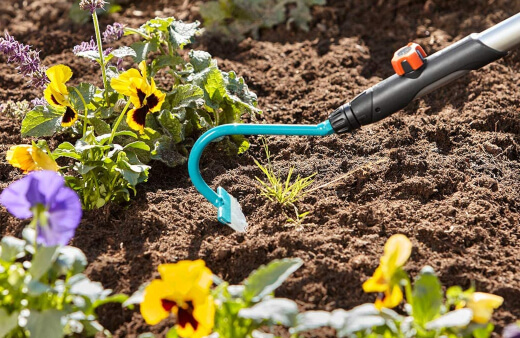
Source: Amazon
- Brand – It’s usually best to go for a well-known brand, as they will have the support needed to assist you if you have any questions.
They will also be the easiest to find in your local garden centre, and the easiest to research for reviews. Good brands include Mattock, Spear & Jackson, Hachiemon, Cyclone, Trojan and Hart, to name a few. - Price – Be prepared to get what you pay for. It’s usually better to go for something a bit more expensive if it offers significantly better quality.
Hoes have to withstand some demanding use, so a cheap garden hoe will likely last you just a season or two before you need to replace it, making it much more expensive than a better quality item in the long run.
How to Use a Garden Hoe
There are several different ways to use a garden hoe. Always remember to wear robust, closed-toe shoes while you garden as the blades are sharp. Remember to wear sun protection and eye protection, as stary stones and grit may fly up.
- Sweeping – Using your hoe, make the same motions you would use to sweep a floor. This can be used to slice off the tops of weeds or brush the surface of the soil smooth.
- Digging – Use the blade of your hoe to cut straight down into the soil and pull towards you to dig out a hole or trench where you can plant seeds or seedlings.
- Covering – You can use the blade to shovel soil around plants, covering the roots or seeds and planting them without needing to bend down.
Garden Hoe Reviews for 2025
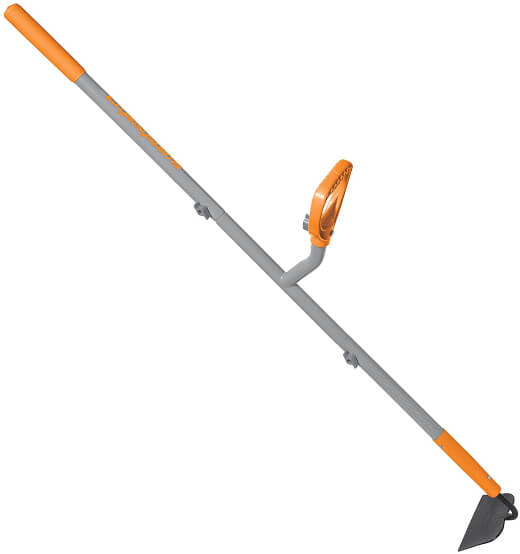


Get Your Free Guide:
Master Growing Australian Natives eBook
A Must Have Complete Guide for Every Australian Garden
Get Your Free Guide:
Master Growing Australian Natives eBook
A Must Have Complete Guide for Every Australian Garden
Designed to support your back as you work, this Snow Joe garden hoe has additional ergonomic features that give you extra leverage while reducing strain on your back. With a large blade, lightweight design and long pole handle, this metal garden hoe gives you good reach as you work.
2. Mattock Medalist® 2kg & Fiberglass Handle Garden Cutter Hoe
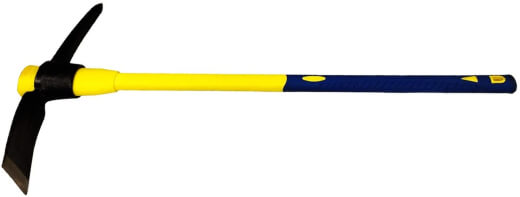
This is a handheld garden hoe that is best suited to trenching, pulling weeds, cutting through tough roots and excavating holes for planting. It has a strong but lightweight non-slip fibreglass handle, and a high-quality head that is built to last. It’s compact and weighs just 2kg.
3. Japanese Craftsmanship Garden Hand Hoe Tool

Made by Hachiemon, this is a 2-in-1 garden hand tool hoe that is powerful, comfortable to work with and built to the highest standards. Made by Japanese craftsmen with a hand-forged head, this tool is sharp, effective and durable.
It has an ergonomic solid oak handle, but still weighs just over half a kilogram in total, making it one of the lightest tools on the market. Ideal for trenching, weeding and removing invader plants, it’s ideal for the everyday gardener and should last a lifetime.
4. Spear & Jackson Dutch Hoe
This is a Dutch hoe featuring a lightweight ergonomic steel pole handle with a comfortable soft grip that helps prevent strain on your hands while you work. At just 1.25 kilograms, it’s one of the lightest long-handle shovel hoes on the market, making it easy for anyone to use. It’s best suited to breaking up soil, weeding and trenching.
Maintaining Your Garden Hoe
As with any gardening tool, your hoes need to be cleaned and maintained properly in order to last.
- Carbon steel heads – Regularly sharpen your garden hoe to maintain performance. First, clean the blade with soap and water, and let it dry. It can be sharpened professionally or you can use an oiled sharpening stone.
- Wooden handles – Always clean the handle well with soap and water after using your garden hoe. You can apply a coat of boiled linseed oil to the handle to keep it from splitting, especially in very dry climates.
First, lightly sand the handle, then brush a thin coating of the oil over the surface. - General – Clean your garden hoe with soap and water after use. Store it in a garage or shed without resting the tool on the blade, as this will blunt it faster. Make sure it is secure, that it cannot fall over, and that it is out of reach of children.

Source: Amazon
Garden Hoe Frequently Asked Questions
What is a garden hoe used for?
Garden hoes are great for cultivating soil quickly, and removing weeds. They are a traditional alternative to ploughs, and while they are slower to use, they are more accurate and much more practical in most gardens.
The most common use for garden hoes is to quickly remove weeds between rows of vegetables.
Is a garden hoe good for weeding?
Garden hoes are the best tool for weeding, and with so many styles to choose from, there’s definitely something to suit everyone, from below-ground hoes, Dutch hoes, and swan neck hoes.
All do the same job, but each will be more comfortable for one person or another, so it’s important to try them out first if you can.
What’s the difference between a garden hoe and a Dutch hoe?
Dutch hoes are forward facing, so are designed to push the soil away from the user, and cut when pulled back. They make quick work of weeding but are less useful for lawn edging or weeding between paving than standard flat-faced hoes.
What is a Japanese hoe?
Japanese hoes look like small scythes, with sharp sideways facing blades. They are ideal for a number of garden tasks, from weeding, to digging rows and troughs in raised beds.
Their sharper face means they are great for stubborn perennial weeds if you need to cut them out regularly, but less effective at digging out entire roots.
Which type of hoe do you push rather than pull?
Most hoes are pulled towards you to remove weeds, but Dutch hoes are designed to push away from you. They are also called loop hoes, and essentially just carve beneath the soil to separate most of the root and top growth from underground root systems, therefore weakening your weeds.
Is it better to pull weeds or hoe them?
The key to effective weed suppression is regular weeding. The quickest way to do that is by using a hoe, which will remove the majority of the plant from the soil, and then simply leave it dry in the summer sun.
However, some deep-rooted garden weeds are better pulled by hand, with a sturdy trowel beneath them to lift the lower sections of root.
Can you use a hoe to remove grass?
Edging hoes are ideal for tidying up the edges of lawns, but to remove grass from your borders where it self-seeds, use a weeding hoe or Dutch hoe to pull out as much root as possible.
Grubbing hoes are great for trimming out sections of turf, and can even be slid under the grass to remove it in sections or reusable turf.
How do you till soil with a hoe?
Hoes are much gentler tools for tilling your soil than spades and forks, and for any gardener looking to pursue no-dig gardening, they help you to remove weeds and aerate your topsoil without damaging the soil life and positive bacteria below.
Is a garden hoe necessary?
Like all garden tools, there are alternatives and ways to use other tools to do the same job as a hoe, but none are ever quite as successful. Hoes are one of those tools that are very necessary in any garden, whether it’s for weeding, tilling, or digging channels in long raised beds to improve reach.
Should I wet the ground before hoeing?
While wet ground will loosen the contact between roots and the soil, it can also be damaging to soil structure to till with a hoe during wet weather. The best way to weed after rain is by hand, making use of the loose contact with perennial weeds, without creating thick clumps of soil.
What is a swan neck hoe used for?
Swan neck hoes are used to break up soil and remove weeds, but they are less effective than loop hoes at bringing them and their roots to the surface, so without a little extra effort you might see your weeds re-sprouting from the roots.
What are onion hoes used for?
Onion hoes are small hand tools with curved handles and a sharp blade at 90 degrees to the ground. They are great for weeding delicately between rows of vegetables and are designed for low-impact weeding without disturbing deeper roots, like onions.
See more of our hands on reviews for different types of garden and landscaping tools below:
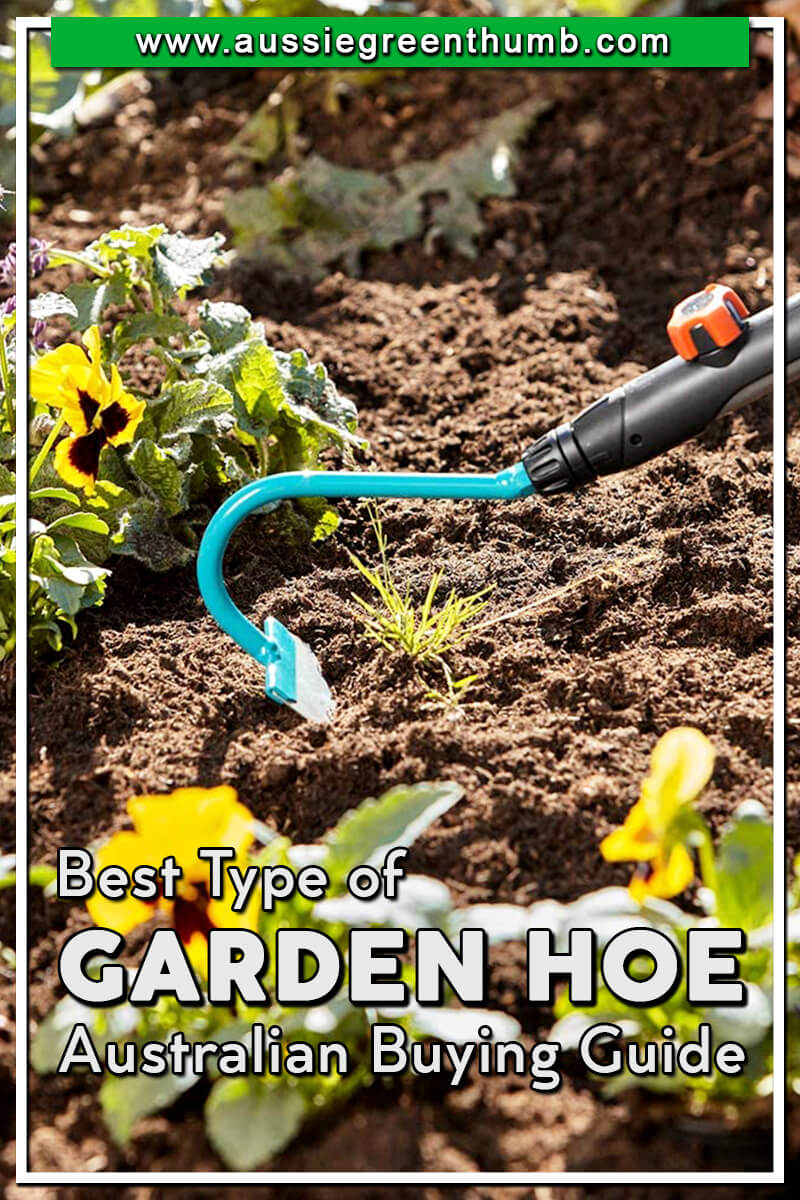
Get The Best Garden Hoe for Your Garden!
I hope this guide helped you choose the right hoe! Remember to consider the type of work you want to do with the hoe, and look for a high-quality tool that will do the job well and last season upon season.
Also, remember to weigh the tool in your hands before you buy, so you find one that won’t be challenging to use or put your back at risk. By following the tips above, you’ll be sure to find the right type of garden hoe in no time!
Published on January 24, 2023 by Gary Clarke
Last Updated on December 23, 2025




